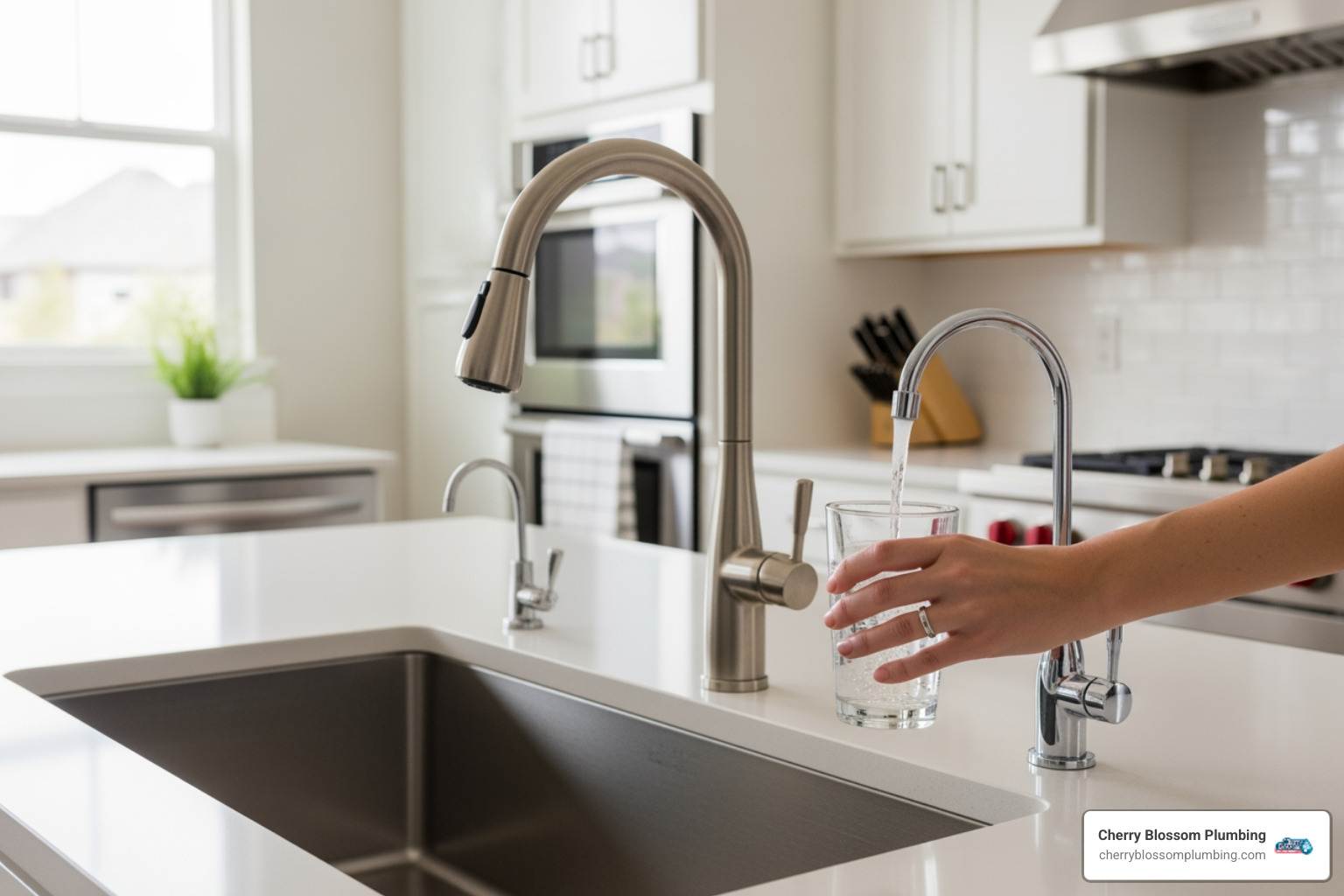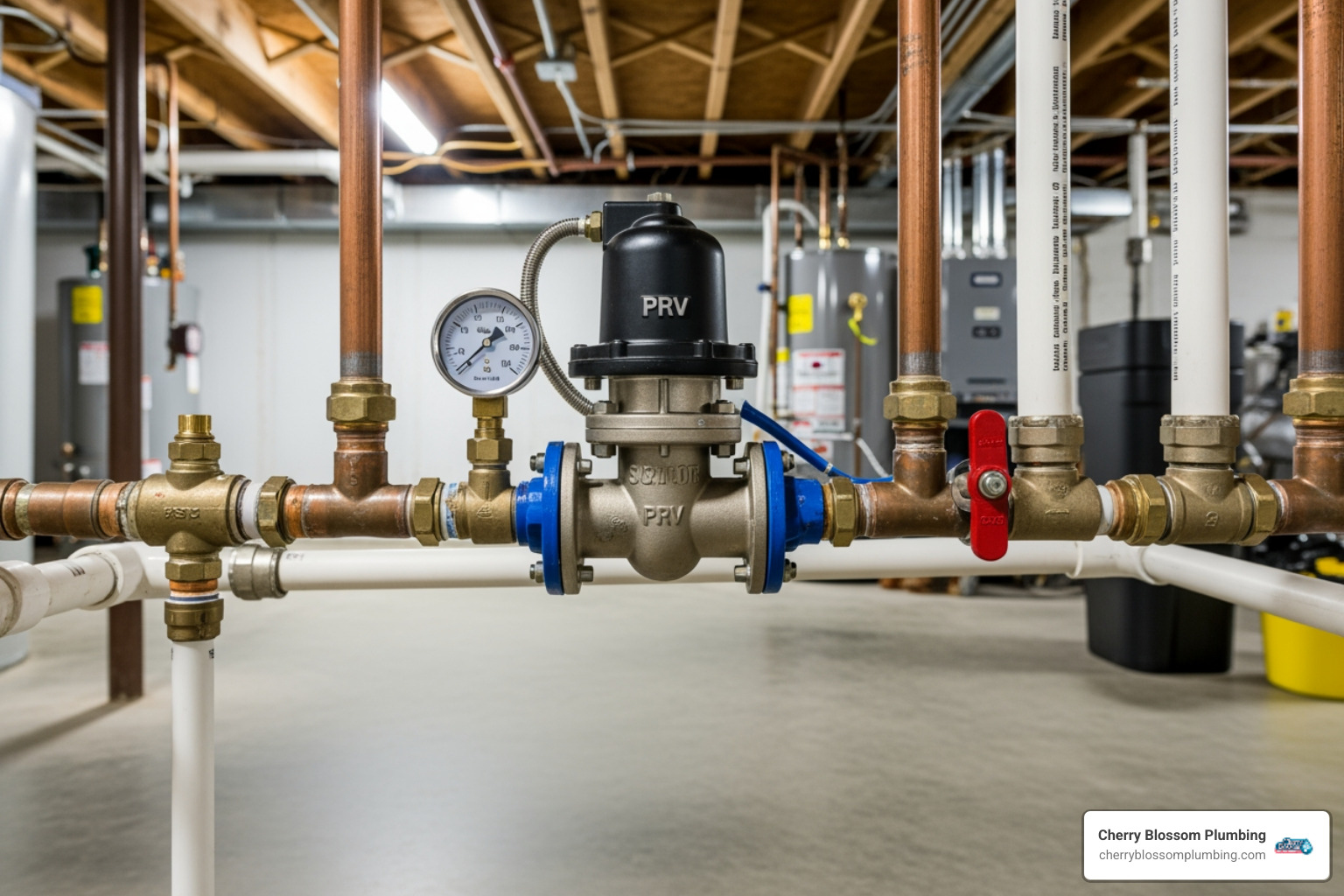
What You Need to Know About 120V Tankless Water Heaters
A 120 volt tankless water heater for shower use is a compact, on-demand water heating solution—but it comes with significant limitations. Here's what you need to know before you buy:
Can a 120V tankless water heater handle a shower?
- Flow Rate: Most 120V units provide only 0.5-0.7 GPM, while standard showers need 1.5-2.5 GPM
- Best For: Low-flow showerheads in warm climates where incoming water is above 70°F
- Temperature Rise: Expect only 24-48°F rise at typical shower flow rates
- Simultaneous Use: Cannot run a shower and another fixture at the same time
- Ideal Applications: Single point-of-use installations, supplemental heating, or guest bathrooms with low-flow fixtures
Bottom Line: A 120V unit works for very specific scenarios—typically a single low-flow shower in a warm climate. For most standard showers, you'll need a higher-voltage unit (240V) or a traditional water heater.
The reality is that most homeowners researching 120V tankless heaters find they need more heating power than these small units can deliver. The appeal of plugging into a standard outlet doesn't outweigh the performance limitations for typical shower use.
I'm Amanda Casteel, and through my work at Cherry Blossom Plumbing, I've helped countless Arlington and Falls Church homeowners evaluate whether a 120 volt tankless water heater for shower applications will actually meet their needs—or if they're setting themselves up for disappointment. My background in process-driven problem-solving helps me cut through marketing claims and focus on what actually works in real-world installations.
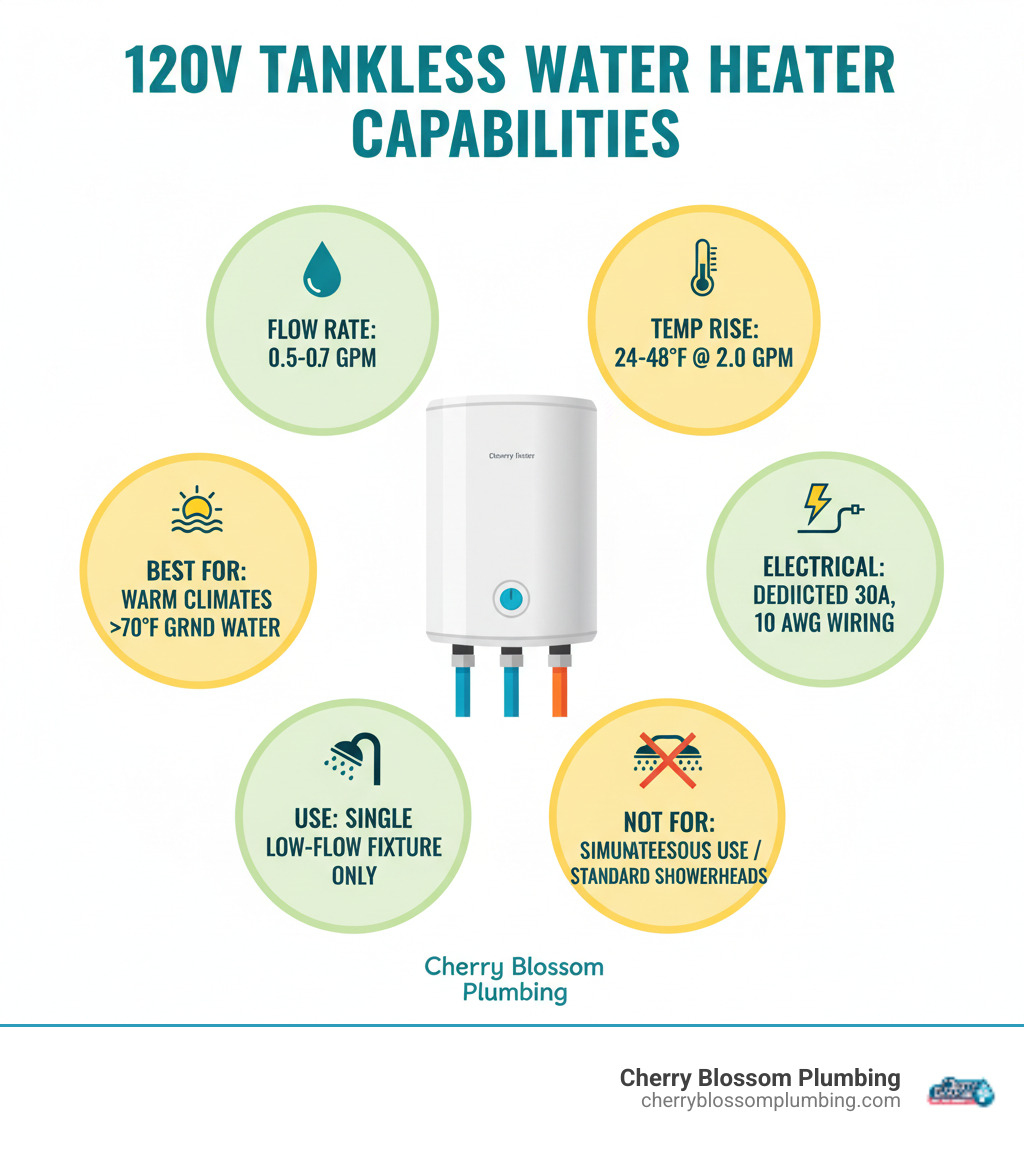
120 volt tankless water heater for shower basics:
Introduction: What is a 120V Tankless Water Heater?
So, what exactly is a 120-volt tankless water heater? In simple terms, it's a compact device designed to heat water on demand, meaning it only heats water when you need it, rather than storing it in a large tank. This type of water heater operates on a standard 120-volt electrical circuit, similar to many common household appliances.
The magic behind a tankless water heater lies in its "on-demand" nature. When you turn on a hot water tap, cold water flows into the unit. A flow sensor activates a powerful electric heating element, which rapidly heats the water as it passes through. Because there's no tank to fill and reheat, you get a continuous supply of hot water, in theory. This process eliminates the "standby heat loss" associated with traditional tank water heaters, where energy is wasted simply keeping a large volume of water hot around the clock. The U.S. Department of Energy highlights that tankless water heaters heat water only as it's needed, making them more efficient.
Most 120 volt tankless water heater for shower units are designed for "point-of-use" applications. This means they are typically installed very close to the fixture they serve, like a single sink in a bathroom or a small utility sink. Their compact size and lower power requirements make them appealing for these specific scenarios where space is limited and hot water demand is relatively low.
The Upside: Key Advantages for Your Shower
While a 120 volt tankless water heater for shower use isn't a perfect solution for everyone, these compact units offer some genuinely appealing benefits—especially when they're matched to the right situation.
Energy efficiency stands out as the biggest win. Unlike traditional tank heaters that constantly use energy to keep a large volume of water hot, a tankless unit only heats water when you turn on the tap. This eliminates standby heat loss and saves energy. According to the U.S. Department of Energy, tankless water heaters can be up to 34% more efficient than conventional storage tank models. That efficiency translates directly to lower utility bills. You can read more about the general Benefits of Tankless Water Heaters on our blog.
The compact, space-saving design is another major plus. These units are about the size of a laptop and can be mounted on a wall, often under a sink or in a small closet, freeing up valuable floor space. This makes them perfect for apartments, tiny homes, RVs, or small office bathrooms.
Another benefit is the promise of endless hot water. Since the unit heats water continuously, you won't run out mid-shower. However, for a 120 volt tankless water heater for shower use, this comes with a major caveat. The unit's limitations on flow rate and temperature rise mean that while the water is continuous, it may not be hot or powerful enough for a satisfying shower. The principle of endless hot water holds true, but the quality of that hot water depends on the unit's capacity and your home's conditions.
Is a 120 Volt Tankless Water Heater for Shower Use Right for You?
Deciding if a 120 volt tankless water heater for shower use is right for you means matching the unit's capabilities to your real-world needs. These units are not designed for whole-house hot water. A 120V heater lacks the power to supply multiple fixtures simultaneously, like a shower and a kitchen sink. Attempting to do so will result in poor performance.
Where these units actually shine is in single-point applications—providing hot water to one specific fixture like a bathroom sink, a utility sink, or a shower under very specific conditions. They can also work as supplemental heating for a fixture far from your main water heater, solving long waits for hot water for low-demand uses.
If you're exploring your options more broadly, our guide on Choosing the Best Tankless Water Heater can help you understand which type of system might better meet your needs.
Flow Rate (GPM): The Make-or-Break Factor for a 120 volt tankless water heater for shower
Flow rate, measured in Gallons Per Minute (GPM), is the critical factor for a 120 volt tankless water heater for shower experience.
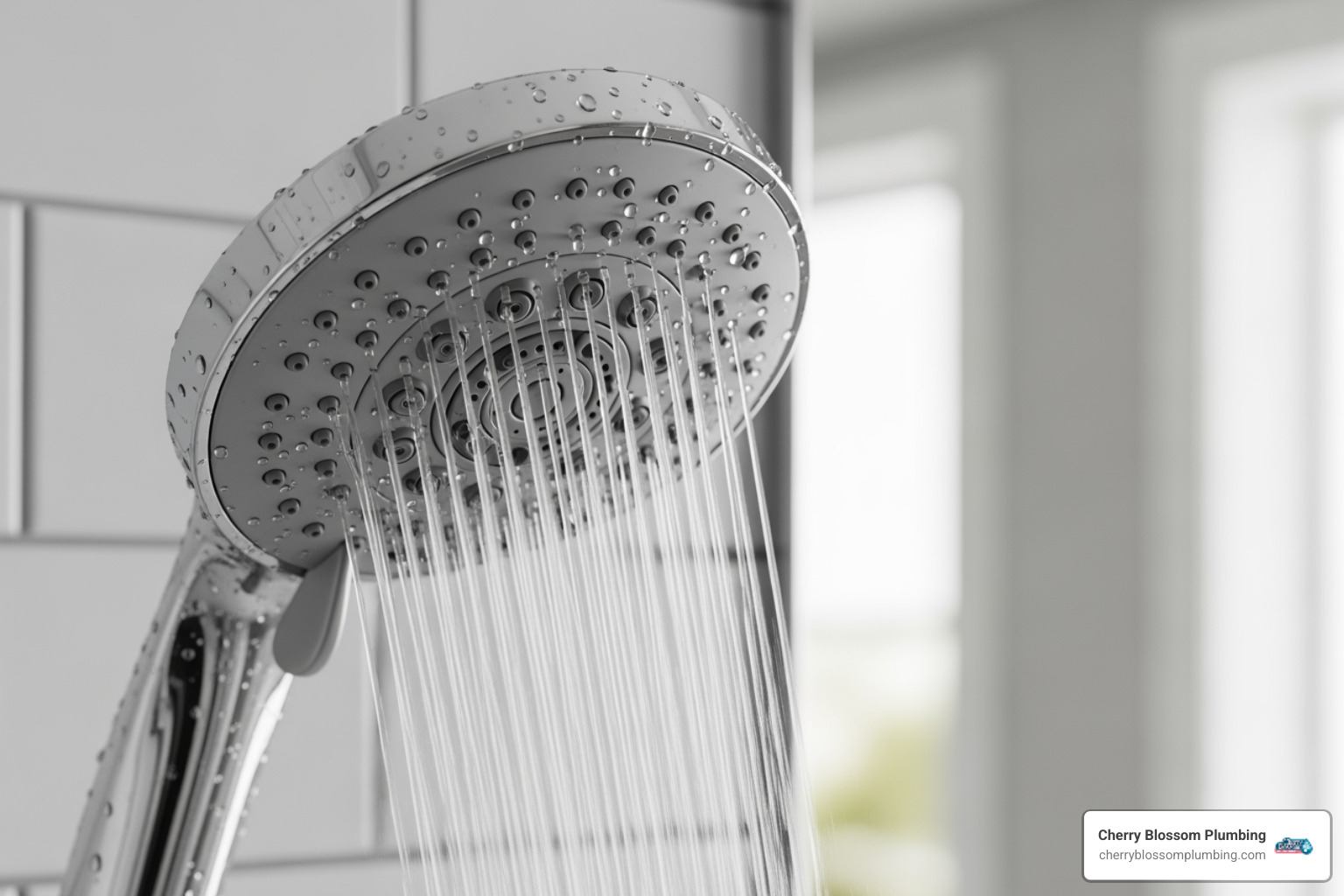
A typical showerhead uses 1.5 to 2.5 GPM, while most 120V units only deliver 0.5 to 1.5 GPM. This gap is why manufacturers recommend low-flow showerheads (1.5 GPM or less) to achieve a satisfactory experience. Without one, you'll likely be disappointed by a weak, lukewarm flow.
Furthermore, simultaneous use is impossible. A 120V unit is designed for one fixture at a time. Running a shower and a sink will result in lukewarm water for both, as the unit cannot meet the demand.
Understanding Temperature Rise and Its Impact
Temperature rise is another critical factor. It's the number of degrees the unit can heat the incoming water. This capability is directly tied to the flow rate—the faster the water flows, the lower the temperature rise.
For example, a 3.5 kW, 120V unit might provide a 95°F temperature rise at 1.0 GPM, but only a 48°F rise at 2.0 GPM.
Consider your incoming water temperature. If your water is 60°F and you want a 105°F shower, you need a 45°F rise, which is achievable at 2.0 GPM. But in winter, if your water is 40°F, you need a 65°F rise. To achieve this, you'd have to reduce the flow rate significantly, resulting in a weak shower. This trade-off between flow and temperature is why proper sizing is crucial, as explained in the U.S. Department of Energy's guide on Sizing a new water heater. Getting it wrong leads to unsatisfactory performance.
Climate Considerations for a 120 volt tankless water heater for shower
Your climate significantly impacts whether a 120 volt tankless water heater for shower is a viable option. Your local groundwater temperature is a key factor.
In warm climates with incoming water above 70°F, these units perform well because they don't have to work as hard to heat the water, allowing for a higher flow rate.
However, in the Mid-Atlantic region, including Arlington and Falls Church, our cold winters cause groundwater temperatures to drop into the 40s or 50s. This forces the unit to produce a much larger temperature rise, which can only be achieved by drastically reducing the flow rate. A shower that feels adequate in summer can become a trickle in winter. This reduced performance in winter is a physical limitation, not a defect. For consistent, year-round performance in our climate, a 120V unit is often insufficient.
Installation and Maintenance Essentials
Installing a 120 volt tankless water heater for shower might look simple, but there are critical electrical and plumbing considerations. Proper installation and maintenance are essential for safety and longevity.
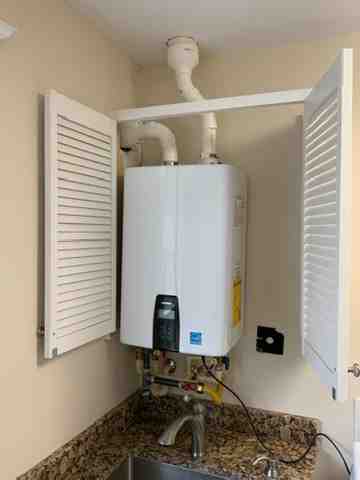
Electrical and Plumbing Requirements
A 120 volt tankless water heater for shower is not a simple plug-in appliance. It requires a dedicated electrical circuit with its own breaker. These units draw a high amount of current (amperage) to heat water instantly. For example, a common model might pull 29 Amps and require a 30A breaker and heavy-duty 10 AWG copper wiring.
Using undersized wiring or a shared circuit is a serious fire hazard and can lead to constantly tripped breakers. For these reasons, professional installation by a licensed electrician or plumber is essential to ensure safety, code compliance, and warranty protection. Our Tankless Water Heater Installation Guide details what a professional job involves.
Plumbing typically involves standard 1/2" NPT water connections, but a professional will also ensure proper pipe sizing, pressure relief valve installation, and correct unit positioning for performance and maintenance.
Keeping Your Unit in Top Shape
Regular maintenance is key to ensuring your 120 volt tankless water heater for shower has a long lifespan of 20+ years.
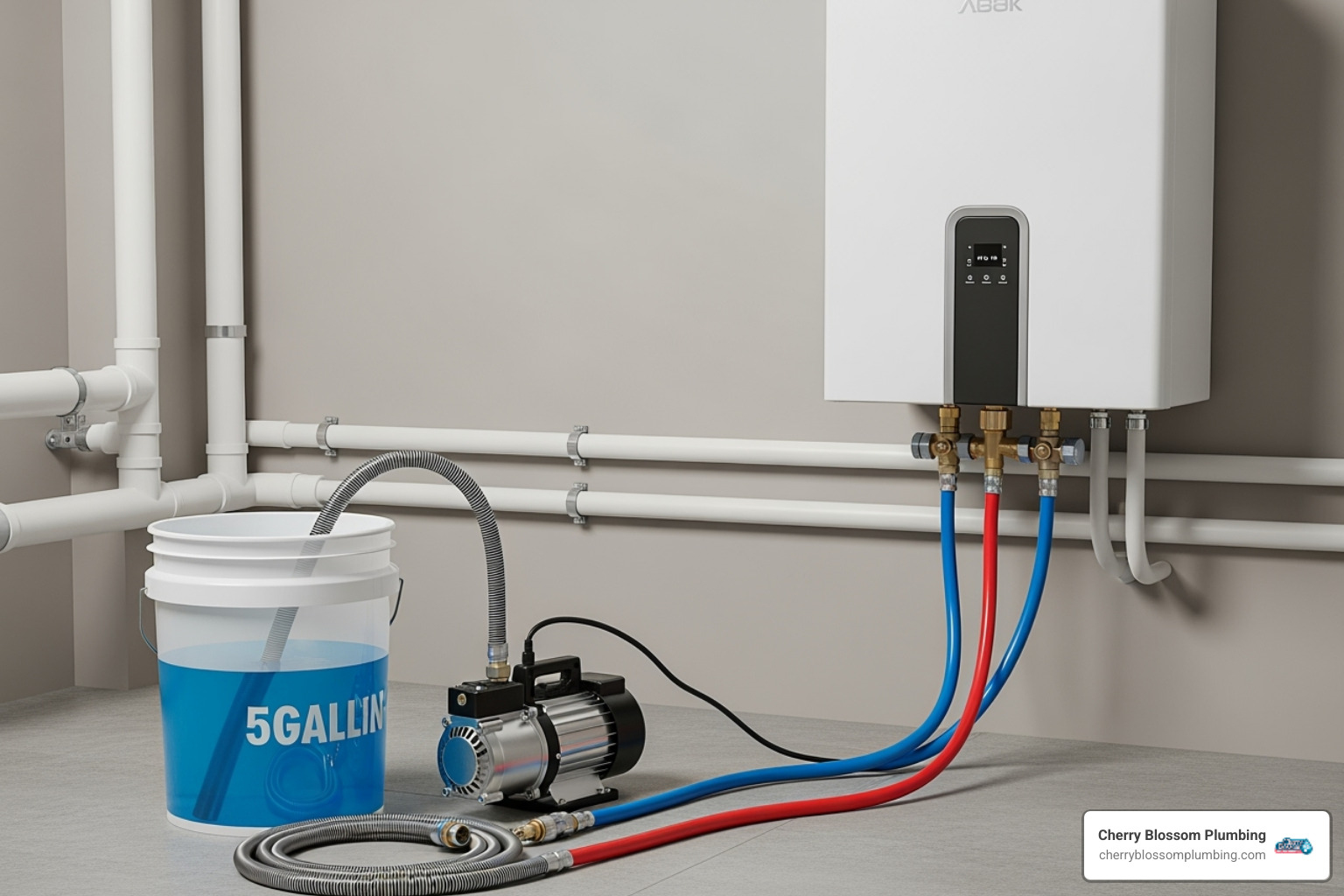
The most critical task is descaling—flushing mineral deposits from the unit. In Northern Virginia, we often have hard water, which causes mineral scale to build up on the heating elements. This scale acts as an insulator, reducing efficiency, restricting flow, and potentially causing component failure. For more details, see our Tankless Water Heater Hard Water Guide.
Most manufacturers recommend annual descaling, or more often in areas with very hard water. Professional maintenance includes this flushing process, along with inspecting connections, checking for leaks, and testing sensors and safety features. This preventative care is essential for long-term reliability. If you encounter issues, our team can assist with Tankless Water Heater Repair. Scheduling annual service will keep your unit running efficiently for years.
Frequently Asked Questions about 120V Tankless Heaters
Through our years serving homeowners in Arlington and Falls Church, we've heard just about every question imaginable about 120 volt tankless water heater for shower installations. Let's tackle the most common ones.
Can a 120V unit supply a shower and a sink at the same time?
No, it cannot. A 120 volt tankless water heater for shower is designed for single, point-of-use applications only. Its heating capacity is insufficient to supply hot water to two fixtures at once. Attempting to do so will result in lukewarm water at both outlets. For simultaneous use, you need a more powerful 240V tankless unit or a traditional tank heater.
Do I need a special showerhead for a 120V tankless heater?
While not technically required, using a low-flow showerhead (1.5 GPM or less) is essential for a satisfactory experience with a 120 volt tankless water heater for shower use. Standard showerheads (1.5-2.5 GPM) demand more water than the unit can effectively heat, especially in colder climates. A low-flow model reduces the water volume, allowing the heater to maintain a more consistent and comfortable temperature. Consider it a necessary component for the system to work as intended.
Is a 120V tankless heater a good choice for a primary bathroom?
For most primary bathrooms, no. A primary bathroom requires reliable, consistent hot water for daily use, which a 120 volt tankless water heater for shower typically cannot provide due to its limitations in flow rate and temperature rise, especially in colder climates. These units are better suited for low-demand applications like guest bathrooms, RVs, or as supplemental heaters for a single sink. For a primary bathroom, we almost always recommend a more powerful 240V tankless unit or a traditional tank water heater to ensure you have the hot water you need every day.
Conclusion: Making the Right Choice for Your Home
So, where does all this leave you? After everything we've covered, it's clear that a 120 volt tankless water heater for shower applications is a bit of a mixed bag. Yes, these compact units offer some genuinely appealing benefits—energy efficiency, space savings, and the promise of on-demand hot water. But they also come with real-world limitations that can't be ignored, especially when it comes to flow rate, temperature rise, and performance in colder climates.
The truth is, these units work beautifully in very specific situations. If you need hot water for a single, low-flow shower in a warm climate where your groundwater stays above 70°F, a 120V tankless heater can be a great fit. They're also excellent for point-of-use applications like a small bathroom sink, a utility area, or even an RV or tiny home where space is tight and demands are modest. As a supplemental heating solution for a specific fixture that's far from your main water heater, they can save both energy and water while providing instant hot water where you need it.
But here's the reality check: for most standard showers, particularly in primary bathrooms or homes in regions like ours here in Arlington and Falls Church, VA, a 120 volt tankless water heater for shower simply won't deliver the performance you're hoping for. If you're picturing a powerful, hot shower after a long day, and your incoming water is 50°F in winter, you're likely setting yourself up for disappointment. The heating capacity just isn't there to keep up with typical shower demands, especially when you factor in our fluctuating seasonal water temperatures.
This isn't about whether the technology works—it does. It's about matching the right tool to the job. And that's where professional consultation makes all the difference. At Cherry Blossom Plumbing, we've helped countless homeowners work through these exact decisions. We'll look at your specific situation, talk through your hot water needs, check out your electrical setup, and recommend a solution that actually works for your lifestyle and budget. No guesswork, no surprises, just honest advice from people who genuinely care about getting it right.
Whether it's a 120V unit, a more powerful 240V tankless system, or a traditional tank heater that makes the most sense for your home, we're here to guide you through the process. Your comfort matters, and your investment should deliver the results you expect.
Ready to explore your options? Contact us for expert tankless water heater services in Arlington, VA. Let's make sure you get the hot water solution that gives you that "WOW factor" every single day.
Customer Testimonials
Cherry Blossom Plumbing has consistently provided top-notch service, ensuring every issue is resolved efficiently and professionally.





